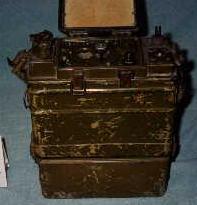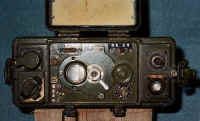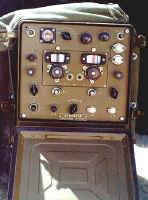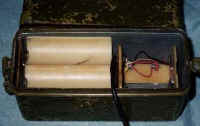|
Home
::
|
North Vietnamese Army Mercury Radios
The Mercury Talk is ruggedly constructed, easy to operate, reliable and completely transistorised. Solid state construction in the Mercury Talk reflects an advancement in the state of the art for PRC communications equipment. Compared to the U.S. Army's AN/PRC-74 B, it is smaller and lighter, but it does not have the frequency range or the transmitting distance of the U.S. radio. Since the Mercury Talk is a continuous tune radio, it may be netted with U.S. AN/PRC-47 and AN/GRC-106 radios. The Mercury Talk is replacing older AM radios as part of an ongoing program to update communications equipment in the PRC Army.
 Mercury Walk Radio |
Mercury Walk Radio There is also a radio identified as the Mercury Walk Radio. It measures 8" x 6" x 3" and with the battery box added on the bottom, it is 11 " high. It is powered by 11 D cell batteries. All controls are on the top panel. It tunes 45 to 50. I assume this is MC. The top panel controls are located under a cover held closed by spring clamps such as found on U.S. military radios. Main tuning control had a lock down lever. Other covered controls were a two position switch and a rotating dial, numbered 1 to 10, presumably a volume control. Two more controls are adjustable by screwdriver and there is a socket for plugging something in, presumably a calibration device. |
On the ends are several more items. A rubber covered push button, presumably for Morse code transmission and the antenna connector are on the right side. The antenna connector requires a special adapter to mount the Russian type Kulikov antenna. On the left side are a 7 pin connector for the head phone/mike set and a multi-position rotary switch which presumably is a function switch. Off/On-Voice-CW.
The set is held in the case by two spring loaded clamps. On removal from the case, the set is modular in construction. There were 7 modules on one side (top) and a flip out module carrier on the other side (bottom) and a circuit board. The resistors looked like a tour through the history of resistors. Some resembled resistors of the 1930s and some looked like modern Radio Shack resistors. Capacitors were moulded of olive drab plastic. There was nothing that looked like a tube socket so I concluded they were again hard wired inside the modules and were not readily apparent.
The central feature of the top side was a 7 gang variable capacitor. There were also three (4 ?) wire coils wound on ceramic forms. On the lower end, adjacent the battery box was a plug, into which the power cable would be plugged. The top section had a plug for something that was missing. It may have been a holder for a crystal for the CW mode. It also appeared that the top was suppose to have a metal cover but that was missing from the set that I have.
 Type 884 Radio |
|
 Type 884 Radio |
|
 Type 884 Radio |
 Type 884 Radio Accessories |
|
 Type 884 Radio Accessories |
|
 Type 884 Radio Accessories |
Back to Communication Equipment of The North
Vietnamese Army and the Viet Cong.
Army Radio Sales Co. Home Page.




